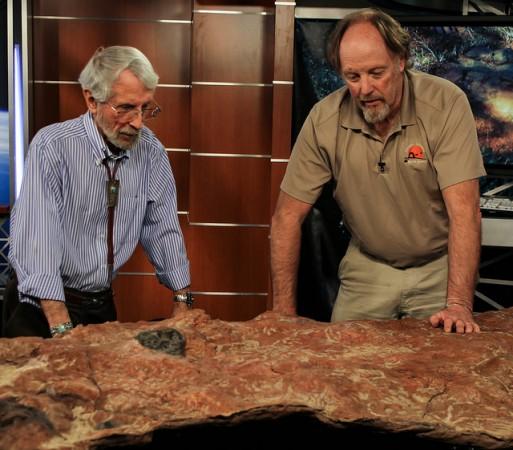
Dinosaurs and mammals used to roam around in Maryland nearly 110 million years ago, especially where NASA's Goddard Spaceflight Centre is currently situated.
Upon discovery of an ancient slab of sandstone, researchers found footprints of dinosaurs, badger-like mammals and flying reptiles on it. Interestingly, all the footprints are well-preserved on the 8.5-foot-long rock.
It looks like small mammals, cousins of the T-rex and a mother dinosaur and her baby all crossed paths on the same rock.
Also read: 800-year-old Arabian pattern chess piece discovered in southern Norway
Surprisingly, the slab had stood there for a long time under everyone's noses. In 2012, amateur palaeontologist and dinosaur fossil hunter Ray Stanford accidentally stumbled upon the long piece of rock while dropping off his wife at work at NASA's Goddard Spaceflight Centre.
In a video, Stanford said while describing his discovery: "I think it's just tremendously exciting."
Now, Stanford along with a team of researchers have jotted down their findings in a research paper which was published in a journal named Scientific Reports.
Martin Lockley, an emeritus geology professor at the University of Colorado at Denver, who was the co-author of the study, said it is quite unusual to have "such a large concentration of different kinds of tracks and small tracks in such a small space."
Lockley was quoted saying in a video: "We're looking at the largest known slab that has animal tracks on it from anywhere in the world. I know of four or five sites in the whole age of dinosaurs that have mammal tracks and some of them only have one or two. Here, we've got approximately 100 footprints on it. It's amazing."
In fact, the slab offers unique insights into the early mammals and the predatory behaviour of the dinosaurs.
Footprints of several dinosaurs remained. At one end of the slab was found a single footprint of a juvenile sauropod — a long-necked plant-eating dinosaur. On the other end, a nodosaur and its baby seemed to have left behind a couple of footprints.
Alongside others, there are footprints of four theropods here and there. These were relatives of the Tyrannosaurus rex, that lived tens of millions of years after them. Theropods were mainly small in size, like a raven.
What left scientists stunned was that although footprints of dinosaurs were found before, they were usually a single impression on a stray piece of rock. This time it happened to have revealed many impressions at once.
The footprints of mammals found on the slab of the rock show the left and right feet of the mammal in a sitting position. And, the scientists have named these prints Sederipes goddardensis which literally means "sitting footprint."
John Foster, executive director of the Museum of Moab in Utah, said the findings were "very interesting to me, especially the mammal tracks and what they show about the structure and probable behaviour." (Foster was not involved in the research.)








